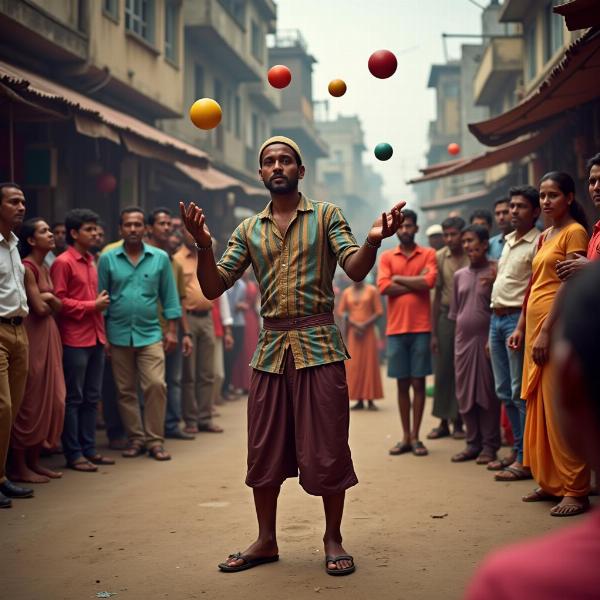Jugglery meaning in Hindi encompasses a rich tapestry of words and cultural connotations. Understanding its true essence requires exploring beyond simple translations and delving into the art’s history, social significance, and linguistic nuances. This article will unravel the various facets of “jugglery meaning in Hindi,” offering insights into its diverse interpretations and cultural impact.
Unraveling the “Jugglery Meaning in Hindi”: Beyond Simple Translations
While a direct translation of “jugglery” might lead you to words like “bazigar” (बाज़ीगर) or “madari” (मदारी), these terms don’t fully capture the multifaceted nature of the art. These words often carry connotations of street performance and magic, sometimes with a slightly negative undertone. However, “jugglery” in its broader sense includes skillful manipulation of objects, often for entertainment, requiring dexterity and precision. Thus, understanding the true “jugglery meaning in Hindi” requires looking beyond basic translations.
 Street Juggler in India
Street Juggler in India
The Nuances of “Hathkhel” (हाथखेल): A Closer Look at Manual Dexterity
A more accurate representation of “jugglery” in Hindi can be found in the word “hathkhel” (हाथखेल), which literally translates to “hand play.” This term emphasizes the skill and dexterity involved in manipulating objects with the hands. It moves away from the magical connotations associated with “bazigar” and highlights the physical aspect of the art form. “Hathkhel” encompasses a wider range of skills, from simple object manipulation to complex juggling routines.
From Entertainment to Metaphor: “Jugglery” in Everyday Hindi
“Jugglery” in Hindi isn’t limited to the literal act of juggling objects. It often finds its way into metaphorical expressions, describing someone skillfully managing multiple tasks or deceptively manipulating situations. For instance, the phrase “hathkhel karna” (हाथखेल करना) can also mean “to manipulate” or “to deceive,” reflecting the dexterity and sleight of hand sometimes associated with juggling.
Jugglery in Indian Culture: A Historical Perspective
Jugglery has a long and rich history in India, dating back to ancient times. Street performers, often referred to as “madaris” (मदारी), would entertain crowds with their juggling feats, often combined with magic tricks and storytelling. These performances were an integral part of traditional Indian entertainment, passed down through generations within families.
What is the Hindi word for “juggler”?
The most common Hindi word for “juggler” is “bazigar” (बाज़ीगर). However, as discussed, “madari” (मदारी) is also used, particularly for street performers incorporating magic and animal acts. “Hathkhela” (हाथखेला), meaning “hand player,” also refers to someone skilled in manual dexterity and object manipulation.
How is “juggling” perceived in Indian society?
Traditionally, juggling has been associated with street performances and entertainment. While appreciated for the skill involved, the profession of a juggler hasn’t always held high social status. However, modern circus arts and contemporary performances are changing this perception, elevating juggling to a recognized art form.
Conclusion: Appreciating the Complexity of “Jugglery Meaning in Hindi”
Understanding “jugglery meaning in Hindi” goes beyond simple dictionary definitions. It requires exploring the various words used, their cultural connotations, and the historical context of the art form. From “bazigar” to “hathkhel,” each term offers a unique perspective on the art of juggling in India. By delving into these nuances, we gain a richer understanding of the art and its significance in Indian culture.
FAQ
- What is the most accurate Hindi translation of “jugglery”? While several words exist, “hathkhel” (हाथखेल) captures the essence of skillful hand manipulation most effectively.
- Is “jugglery” only about entertainment in India? No, it also carries metaphorical meanings related to multitasking and manipulation.
- Are there different types of jugglers in India? Yes, from traditional street performers (“madaris”) to modern circus artists.
- What is the cultural significance of juggling in India? It has a long history as a form of entertainment, passed down through generations.
- Is the perception of juggling changing in modern India? Yes, with the rise of contemporary circus arts, it is gaining recognition as a respected art form.
- Besides “bazigar,” what other words describe a juggler? “Madari” and “hathkhela” are also used.
- How is “jugglery” used metaphorically? It can describe someone skillfully managing multiple tasks or manipulating situations.
Meaning-Hindi.in offers expert translation services for various content types, including business documents, legal papers, technical manuals, websites, and academic materials. We specialize in accurately conveying nuanced meanings between Hindi and other languages, ensuring your message resonates perfectly with your target audience. Our expertise in cultural adaptation ensures your content is both linguistically accurate and culturally sensitive. For all your Hindi translation needs, contact us at [email protected] or call +91 11-4502-7584. Connect with Meaning-Hindi.in for seamless communication across languages.